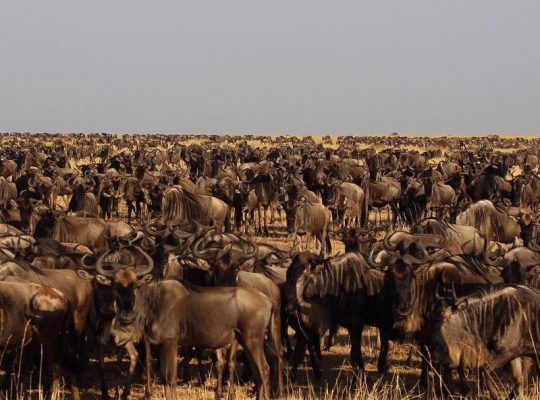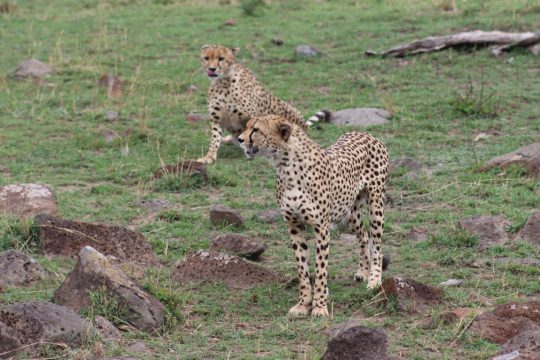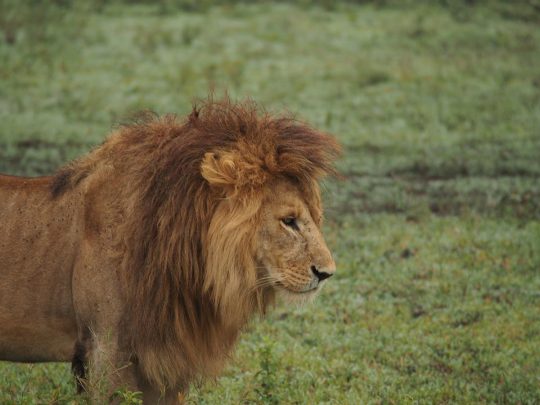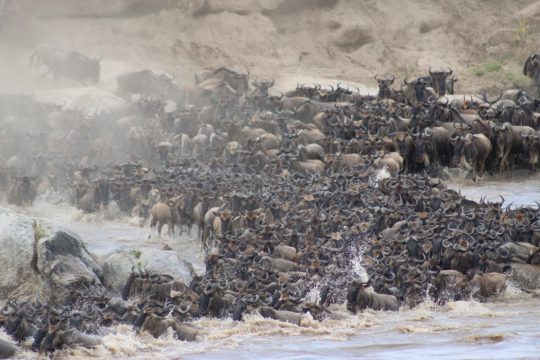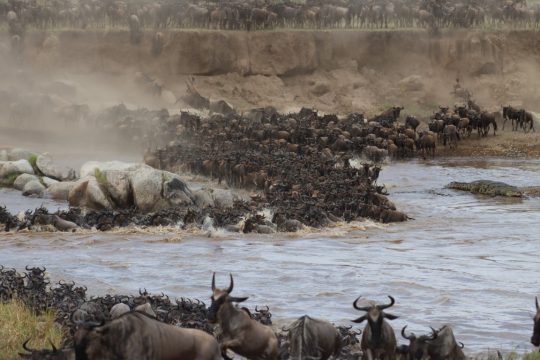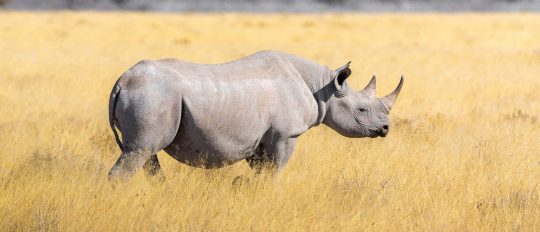Serengeti National Park
Are you thinking to go on safari in Serengeti?
Talk to our experts about the perfect planning for your holiday.
Error: Contact form not found.
- About Serengeti
- Interesting facts about Serengeti
- Best Time to Visit Serengeti
- Getting to Serengeti
- Things to see in Serengeti
- Things to do in Serengeti
- Where to Stay in Serengeti
- Weather & Climate
The Serengeti National Park is Africa’s most famous tourist destination.
About Serengeti National Park
The word Serengeti comes from the Maasai word Siringet which means “endless plains”. The whole Park is a UNESCO world heritage site and covers 14,763 square kilometers.
Serengeti is among the richest grazing grounds in African bush composed of endless grassy plains. The park is well known for an incredible number of predators, over 500 species of birds, and a concentration of more than two million grazers of the great migration.
Serengeti is the most outstanding wildlife reserve in the world, nowhere else to match its awesome experiences. The formation of Kopjes in the north, endless plains in the south, breathtaking sunset, and concentration of animals makes a safari in the Serengeti so remarkable.
Famous for:
Annual Wildebeest migration
The Annual Wildebeest Migration in Serengeti
More than two million animals migrate from Serengeti National Park to Maasai Mara Game Reserve every year. The annual movement of wildebeests is accompanied by other animals such as zebras (the leaders of migration), Grant gazelles, Thomson gazelles, and Impalas. The annual wildebeest migration is the greatest reason that has made Serengeti national park one of the world’s natural wonders.
The annual wildebeest migration takes place in four main areas as follows:
Serengeti South/Ndutu area (The Calving season)
Duration: December to March
The early stages of Migration commence when the herds are in Calving. The calving season event takes place in Ndutu the Southern part of Serengeti in the Ngorongoro Conservation Area. Once the calving season is over and the calves have already fed on the nutrients of the Ndutu area, the migration to the central part of Serengeti.
Serengeti Central/Seronera area
After the calving season, the great migration proceeds to the central part of Serengeti known as Seronera. The area is filled with enough grasses, water sources, and nutrients to feed the herds of migration. Exceptional big games are guaranteed in this area due to the high concentration of animals. The herds spend some time in this area to gain more strength before proceeding with their journey to the North via western corridors.
The Western Corridor and Grumeti
Duration: May to Mid-July
The Western Corridor follows the path of the Grumeti River. This region provides great wildlife action around May and June when the migrating herds cross the shallow water of the river Grumeti and proceed their journey to the North. The western corridor is a great area for unspoiled wildlife viewing.
Serengeti North/Mara river Crossing
Duration: July to October
The great migration of wildebeest in Serengeti’s Northern part involves the Mara River crossing. This event takes place from around August to late October (sometimes the crossing may prolong to early November). The migration will stay in Masai Mara Game reserve before coming back to South Serengeti for the Calving season in February.
Interesting Facts About Serengeti National Park
Africa’s Leading National Park
- Serengeti was rated as the best safari park in 2015 & 2018 by Safari Bookings which analyzed more than 3,000 reviews from safari tourists and industry experts alike.
- Serengeti was crowned Africa’s Leading National Park of 2020 by World Travel Awards. That was the second time in a row.
- In 2021 TripAdvisor announced Traveler’s choice for the best National Parks in the world where Serengeti topped the list.
- The name Serengeti is derived from the Maasai word siringet, meaning “endless plains due to its hugeness.
The Great Migration
- The Serengeti migration involves more than 1.7 million wildebeest, 500,000 zebra, and 200,000 Impala
- The Great Migration of the Serengeti was selected in 2013 as one of the Seven Natural Wonders of Africa
- During its peak, more than 8,000 young wildebeests are born daily for up to 3 weeks.
When to Visit Serengeti National Park
All-year-round depending on interests.
Mara River crossing by wildebeests for example is from July to October
Wildebeests calving season – January through March
Big cats – January through December
To focus solely on the wildebeest Migration would be the best idea for a visit to Serengeti. Even taking the wildebeest Migration out of consideration, still Serengeti can be argued as the finest park in Africa.
In a nutshell, you can see the Great migration year-round. The park can be visited any time of the year depending on what event exactly you would like to experience during the circular movement of the great migration. Exceptional big games from predators are guaranteed during the great migration safaris.
A month-by-month guide to the migration movement
Let’s break down some ideas that will give you a better understanding of a visit to Serengeti National park. Below is a month-by-month guide that shows exactly where to find the herds of migration.
From December to March
During this period of the year, the migration herds are likely to be found in the Southern parts of Serengeti on the upper parts of the Ngorongoro Conservation Area (Ndutu Area). This place is considered the best ground for calving season.
Why southern Serengeti is the best ground for calving season?
In the Southern Serengeti, there are shorter grasses that make it an ideal ground to give birth. The open plains ensure security as the herds can see the predators very easily, hence protecting their Calves.
Southern Serengeti land is so fertile due to the remains of the volcanic ashes after the eruptions. The grounds provide grasses with enough nutrients to feed the calves. Therefore the herds won’t leave the area until their calves have got enough nutrients from the fresh grasses of Southern Serengeti.
April and May
This is the period when some of the migration herds start to move from Southern Serengeti towards other parts of Serengeti. During this time of the year, the Ndutu area is still the best place to be as the herds can be witnessed in a bit dispersed way.
In April Cat viewing becomes another awesome experience in Southern Serengeti due to the presence of resident Cats in the Ndutu Area. Nevertheless, this zone offers an amazing live predatory action.
From May, most of the Migration herds will proceed with their journey to reach the Northern Parts of Serengeti, however, this time of the year is the best moment to experience the migration in the central parts of Serengeti.
Other herds move to the Western corridor around the Grumeti area. In May you will experience heavy rains in many areas of Serengeti hence forcing the herds to disperse and probably won’t see them in large concentration.
June and July
The mating period brings together the herds of the migration in the Northern part of Serengeti. Before they give birth in February, the wildebeests gestation period.
During these months some of the herds are herding to the Western Serengeti, where you may witness wildebeest crossing the Grumeti River as the herds leave the park to enter the Singita Game reserve.
In July, the Kogatende area is the best place to be. During this period herds can be seen anywhere around Central, West, and Eastern Serengeti.
August, September, and October
Even though Migration can be experienced the whole year round, this is arguably the best month for the Mara river crossing.
Kogatende area is again the best place to be during this period as it gives you the best experience to see the huge number of wildebeest crossing the Mara River full of hungry crocodiles. You will also witness the big cats closely on the sidelines waiting to capture the herds.
On the contrary, not necessarily that the herds will go to the North after they have stayed in the central and western corridor of Serengeti. Some may decide to go back to the South or proceed to the north and cross the Mara River depending on the direction of Rainfall.
From November
Since rains are the main determinant of the great migration movements, there is no fixed rule for this memorable event. Hence during November, you may still be lucky to witness some of the wildebeest crossing the river, though during this time the herds start their journey to the South ready for calving season in early February.
Getting to Serengeti National Park
Two airways lead you to Tanzania & Serengeti
Kilimanjaro International Airport (JRO)
Julius Nyerere International Airport (JNIA)
However, for your safari goals, Kilimanjaro International Airport serves you the best.
Kilimanjaro International Airport (JRO)
Kilimanjaro International Airport (JRO) is situated 46km/29mi east of Arusha, the gateway of Tanzania’s most popular Northern safari circuit including Serengeti.
From Arusha, it is a long but scenic 6-7 hours drive to Serengeti. There are also local flights from Arusha to different airstrips in Serengeti Park.
Julius Nyerere International Airport (JNIA)
Tanzania’s main airport is Julius Nyerere International Airport (DAR) located 13km/8mi southwest of Dar es Salaam. This is the entry-point for visitors to the southern parks (Mikumi, Selous, Ruaha national parks).
Moving on from Dar es Salaam to Arusha you can fly or drive. However, a drive will take 10-12 hours via public transport. You can also get a transfer from Dar es salaam to Arusha via private vehicle, however, this is expensive.
There’re local flights from Dar es Salaam to Arusha which land at Kilimanjaro International Airport or Arusha Airport.
We usually advise our clients to minimize unnecessary costs by flying to Kilimanjaro International airport. The only exception to this is when someone has to go to Dar es salaam first for various reasons.
Things to See in Serengeti National Park
Serengeti has several attractions to explore and each attraction is very unique compared to the other. Serengeti is one of the Wildlife Reserves in the world with a huge number of attractions, this has made Serengeti one of the most visited parks in Africa. Below is the list of the most spectacular things to see in Serengeti national park:
- More than 2 million animals of great migration including the herds of Wildebeests, Zebras, Gazelles, and Impallas
- More than 3,000 lions live in this ecosystem
- More than 20,000 African Buffalo
- Up to 500 species of birds
- Leopards, Cheetahs, and other Cats species
- Hippos, Crocodiles, Giraffe, and many other animal species
Things to Do
Serengeti has (countless) activities to explore and every activity is very impressive. This has left visitors with no option rather than visiting Serengeti a whole year-round. Below is the list of the most extraordinary things to do in Serengeti national park:
- Great wildebeest migration Safari
- Hot air balloon
- Big Game viewing
- Bird Watching
- Calving season experience
- Live predation
- Maasai rock paintings
- Guided walking safari
Weather & Climate of Serengeti National Park
While the weather is moderately cool in Serengeti, it may get cold at night
Dry season: from June to October
Wet Season: from November to December
Wetter Season: from March to May
If you liked Serengeti National Park, you might also like Ngorongoro Conservation Area.
For more content like this, please follow us on Instagram.
Do you need expert tips on planning for your next safari in Africa?
Share your email here
[mc4wp_form id=”29279″]

